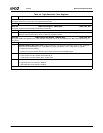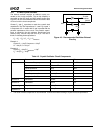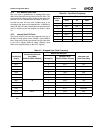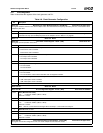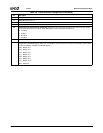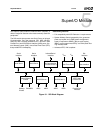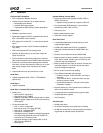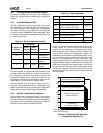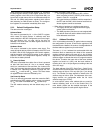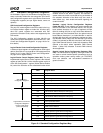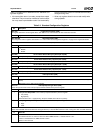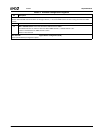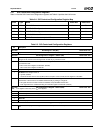
96 AMD Geode™ SC2200 Processor Data Book
SuperI/O Module
32580B
5.1 Features
PC98 and ACPI Compliant
• PnP Configuration Register structure
• Flexible resource allocation for all logical devices:
— Relocatable base address
— 9 parallel IRQ routing options
— 3 optional 8-bit DMA channels (where applicable)
Parallel Port
• Software or hardware control
• Enhanced Parallel Port (EPP) compatible with version
EPP 1.9 and IEEE 1284 compliant
• EPP support for version EPP 1.7 of the Xircom specifi-
cation
• EPP support as mode 4 of the Extended Capabilities
Port (ECP)
• IEEE 1284 compliant ECP, including level 2
• Selection of internal pull-up or pull-down resistor for
Paper End (PE) pin
• PCI bus utilization reduction by supporting a demand
DMA mode mechanism and a DMA fairness mechanism
• Protection circuit that prevents damage to the Parallel
Port when a printer connected to it powers up or is oper-
ated at high voltages, even if the device is in power-
down
• Output buffers that can sink and source 14 mA
Serial Port 1
• 16550A compatible (SIN1, SOUT1, DTR1#/BOUT1
signals only)
Serial Port 2
• 16550A compatible
Serial Port 3 / Infrared (IR) Communication Port
• Serial Port 3
— SIN and SOUT signals only
— Data rate of up to 1.5 Mbps
— Software compatible with the 16550A and the 16450
— Shadow register support for write-only bit monitoring
— DMA support
• IR Communication Port
— IrDA 1.1 and 1.0 compatible
— Data rate of up to 115.2 Kbps (HP-SIR)
— Data rate of 1.152 Mbps (MIR)
— Data rate of 4.0 Mbps (FIR)
— Selectable internal or external modulation/demodula-
tion (ASK-IR and DASK-IR options of SHARP-IR)
— Consumer-IR (TV-Remote) mode
— Consumer Remote Control supports RC-5, RC-6,
NEC, RCA and RECS 80
— DMA support
System Wakeup Control (SWC)
• Power-up request upon detection of RI2#, CEIR, or
SDATA_IN2 activity:
— Optional routing of power-up request on IRQ line
• Pre-programmed CEIR address in a pre-selected
standard (any NEC, RCA or RC-5)
• Powered by V
SB
• Battery-backed wakeup setup
• Power-fail recovery support
Real-Time Clock
• A modifiable address that is referenced by a 16-bit
programmable register
• DS1287, MC146818 and PC87911 compatibility
• 242 bytes of battery backed up CMOS RAM in two
banks
• Selective lock mechanisms for the CMOS RAM
• Battery backed up century calendar in days, day of the
week, date of month, months, years and century, with
automatic leap-year adjustment
• Battery backed-up time of day in seconds, minutes and
hours that allows a 12 or 24 hour format and adjust-
ments for daylight savings time
• BCD or binary format for time keeping
• Three different maskable interrupt flags:
— Periodic interrupts - At intervals from 122 msec to
500 msec
— Time-of-Month alarm - At intervals from once per
second to once per month
— Update Ended Interrupt - Once per second upon
completion of update
• Separate battery pin, 3.0V operation that includes an
internal UL protection resistor
• 7 µA typical power consumption during power down
• Double-buffer time registers
• Y2K Compliant
Clock Sources
• 48 MHz clock input
• On-chip low frequency clock generator for wakeup
• 32.768 KHz crystal with an internal frequency multiplier
to generate all required internal frequencies



